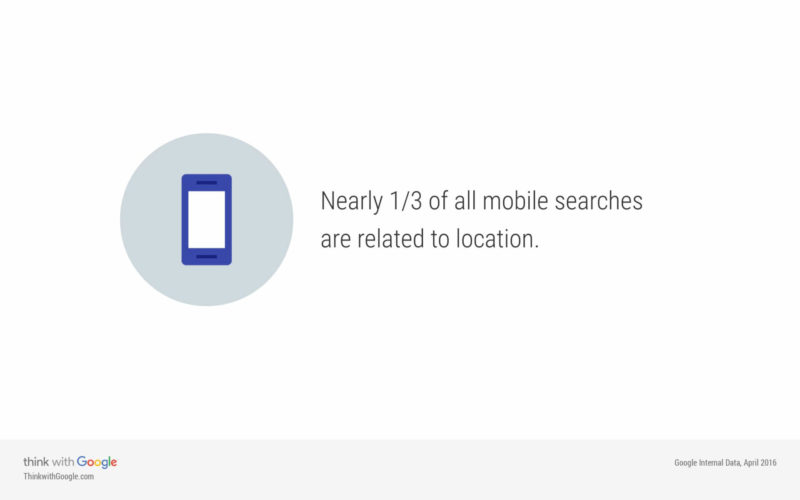
The rise of mobile search has led to many changes in SEO, but none more dramatic than the area of local search.
By now, most of us are familiar with the Google update known as Pigeon. Launched in 2014, it allowed greater search visibility for local directories, which helped local search engine optimization (SEO) establish a foothold. With mobile usage surpassing desktop and Google reporting more than one-third of mobile searches local related, it’s no wonder local SEO has become an important part of an SEO’s overall strategy.

Competing for local SEO is quite difficult considering the shrinking real estate of local results in search engine results (SERPS), especially over mobile devices. What strategies should we use to increase our organic visibility and rankings in local search results? Here are four to consider:
- Claim all local name, address and phone number (NAP) citations and listings you can in local directories, and be sure they are consistent across all listings.
- Claim your Google My Business Page and Bing Places For Business and fill each with relevant information and local keywords to get spotted in a local search. Doing so helps your business show up in search results plus Google and Bing Maps.
- Improve local ratings and reviews to rise above the local search pack by fully optimizing your webpages and completing all information fields in Google My Business.
- Produce local content to rank for long-tail keywords and below-the-fold results.
For the purpose of this article, we’re going to focus on producing and optimizing local content since it is one of the best ways to boost your visibility and rankings in local search results.
Optimizing content for Local SEO
Local SEO is a great strategy for small businesses and service industries that primarily market in a set geographic area. By focusing content on local keywords and intent, you effectively narrow the competition and your reach to your target audience. Smart!
The two most important steps to optimizing your website for local intent are making your website mobile-friendly and localizing your schema markup.
A survey sponsored in part by Microsoft (download required) found only 17 percent of marketers incorporated schema markup in their websites. Adding structured data to your website communicates the focus of your content and the geographic area of your business to search engines. While this does not directly improve rankings, it makes your webpages highly relevant to local keywords you are targeting. This is also helpful for ranking in local search packs.
When producing content for local intent, it’s key to insert local keywords into title and meta description tags for local ranking. Your content will often focus on long-tail keywords to delineate your site topically and geographically. For example, overarching webpages may include “Seattle SEO Firm,” while a blog post could include “Best SEO Firms in Seattle.”
The insertion of Seattle in both pages, while necessary for the second, will help Google index your content for Seattle and SEO-related searches. It’s also recommended to insert geographic keywords as close to the beginning of the tag as possible so it’s not truncated in search results.
For businesses with multiple locations, this becomes necessary, as they often have the same location pages for separate locations. Beyond updating NAP information, consider adding relevant information such as local landmarks nearby and testimonials from local businesses you’ve served.
Local content ideas
Localized content is a great way to capture a niche not many people are tackling. Aside from local news stations and influencers, most websites don’t focus on localized content, aside from real estate and travel websites like TripAdvisor and Movoto.
Before producing localized content for your area, conduct some research to identify your target audience. The best way to do this is by taking advantage of being local and interviewing customers face-to-face.
Using search terms and criteria from your face-to-face meetings, conduct an extensive audience analysis using Facebook’s Audience Insights. This will help you identify the demographics and psychographics of your audience and help you curate content that appeals to them.
You can also use Google’s Keyword Planner to measure search volumes for select keywords based on insights provided from face-to-face interviews and your own local keyword tactics. This will help you find target audience members you haven’t reached yet.

You should also consult your analytics to audit your current traffic data and website performance. Are people reaching you through direct traffic, social or search? What keywords are they using in search? This is crucial, not only for selecting topics for local content creation but also for finding the best channels to publish and promote.
One thing to keep in mind is that local content isn’t simply a blog post. Local content marketing incorporates a number of different strategies, including sharing user-generated content, optimizing landing pages with local images and descriptions and optimizing online reviews.
For blog posts or landing pages, there are a number of content ideas you can pursue for this strategy, including:
- Local event write-up.
- Piggybacking local news stories.
- Content centered on your business.
- Content centered on your industry and unique to your area, such as “How Seattle’s Minimum Wage Laws Affect Retailers.”
- Answering local questions, such as “What are the Best Places to Shop in Washington, D.C.?”
- Generating local media coverage.
You can also become active in your community to inspire ideas for local content so you can report firsthand and be authentic in your writing. Ideas include:
- Hosting local events.
- Attending local events.
- Sponsoring local events.
- Guest posting on local blogs.
- Guest lectures at universities or local schools.
Beyond merely creating local content to rank in a search engine, the main idea is also to position your brand as a local community leader. That is why it’s important to strategically position, publish and promote content on different channels. Social should be the primary channel, but high-ranking local landing pages will also provide a good opportunity for listicles and valuable local information. Blogs should be reserved for more topical content, such as local news events.
Local link building
Local SEO also presents a valuable opportunity to create linkable assets, focused on local research and statistics. For example, many real estate companies benefit from listing local housing statistics on their websites. This creates a prime opportunity for bloggers and local media to reference these statistics.
This isn’t necessarily reserved for housing and travel verticals. Heating companies could list energy pricing statistics for their geographic area, and law firms could write detailed mockups of changing laws in their city.
Local link building already aligns with current SEO strategies:
- Acquiring directory links and mentions.
- Inserting landing page links into relevant citations.
- Acquiring local media coverage.
- Local guest blogging.
All of the content strategies I have listed — from hosting an event to giving guest lectures — all present opportunities to build more links. Depending on your geographic location, you can always apply to become a guest columnist for national publications with local and metro sections.
Local SEO is an untapped opportunity
When we think of local SEO, we often think of just the basics, acquiring local directory links and registering for Google My Business. While these are important, local SEO has many more advantages over broad SEO, especially with the continued rise of mobile search.
The post How to create content to support local SEO and rock the rankings appeared first on Search Engine Land.
No comments:
Post a Comment